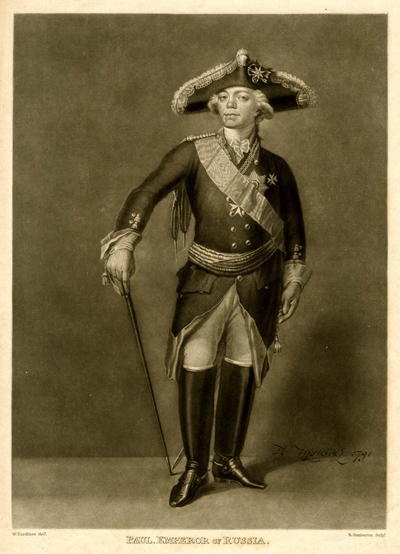The Magnanimous Ally
This is the first of two versions of a portrait caricature of Paul the First, Emperor of Russia, son of Catherine the Great. It was published in September 1799 when Russia under Field Marshall Suvarov had already scored major victories over the French revolutionary forces in Italy as part of what was later called the Second Coalition. Identified by the Russian symbol for P within which is a one (positioned in the sky over his head), Paul the First is shown standing proudly upon a tattered French flag.

© Lewis Walpole Library, Yale University
Gillray's print may owe something to the mezzotint of Paul, Emperor of Russia by Robert Dunkarton based on a painting by Stepan Semenovich Shchukin in 1791.

Paul, Emperor of Russia [After 1791]
© Trustees of the British Museum
The full length presentation, posed with walking stick, in military dress is similar in both. Though Gillray has turned Paul's head to show his profile in conformance to classic portrait caricature tradition, the face is clearly individualized. If not this particular mezzotint, Gillray must have worked from an existing model like this one. And he must have come upon it not long before The Magnanimous Ally was published. Prints of Gillray's portraying the Russians as allies as recently as May 1799 do not include a likeness of Paul, but instead use the national symbol of a Russian bear.
The print also owes something to what seems to have been standard practice of presenting military figures standing on a barely defined eminence against a minimally defined background of sky, smoke, or clouds. Sometimes, the military victories are shown in the distance. In Gillray's work, examples abound, including Portrait of an Irish Chief. . . (July 10, 1798), The Hero of the Nile (Dec. 1, 1798), and A Man of Importance (May 16, 1799).
The title of the print, The Magnanimous Ally, orginates with language used consistently and from the very beginning of Russia's alliance with Britain against the French revolutionaries. In the Gentleman's Magazine for November of 1798, for instance, amid congratulation for Nelson's recent victories in Egypt, we hear that
much praise [is] also due to Ministers for their able negociations inducing the Emperor of Russia and the Ottoman Empire to set the magnanimous example of entering into a general combination to check the disturbers of Europe.
During the debates in Parliament on a Russian subsidy, Lord Grenville, according to the Evening Mail for June 10, 1799, made reference to "the conduct and example of that magnanimous personage [i.e. Paul I] to whom it was now proposed to vote a subsidy." And during the same debates, Pitt pointed out (as reported in Cobbett's Parliamentary History Volume 34),
This magnanimous and powerful Prince [Paul I] has undertaken to supply, at a very trifling expense, a most essential force, and that for the deliverance of Europe.
The deliverance of Europe was not as easy as Pitt supposed, however, and when the mercurial and eventually much-hated Paul abandoned the alliance in 1800, Gillray issued a revised and deeply ironic version of the same caricature.
Sources and Reading
- Commentary from the British Museum on The Magnanimous Ally.
- Draper Hill, Mr. Gillray The Caricaturist, 1965, p. 81n
- "Paul I of Russia," Wikipedia
- "War of the Second Coalition," Wikipedia
- "Campaigns of 1799 in the French Revolutionary Wars," Wikipedia
- Thomas Wright and R.H. Evans, Historical and Descriptive Account of the Caricatures of James Gillray #256
- Thomas Wright and Joseph Grego, The Works of James Gillray, the Caricaturist; With the History of His Life and Times p. 273.
Comments & Corrections
NOTE: Comments and/or corrections are always appreciated. To make that easier, I have included a form below that you can use. I promise never to share any of the info provided without your express permission.